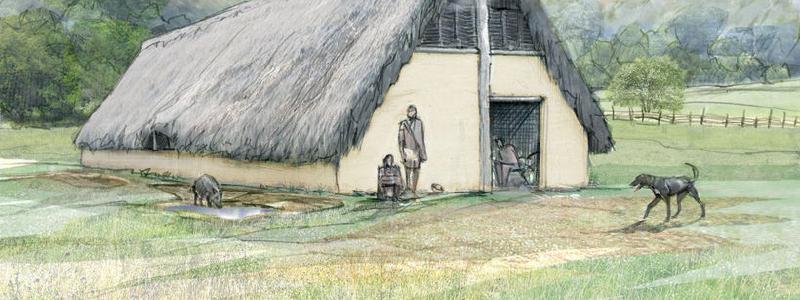Human Perception and Neolithic House Orientation

Lifestyles of the Neolithic
It is about 8,000 years ago in Central Europe. You and your clan are trying out the latest lifestyle craze “farming”. You live in what modern scholars call “longhouses” - 15-20 feet wide and around 100 feet long, short walls with an extreme pitched roof.
You were born in this house; your children were born in this house. But now it is time to build a new one1.
The clan picks a spot about 100 yards away from the old house and rebuilds. For reasons only known to you, you go to particular pains to make the new house have the same orientation as the old - the new house will be parallel to the old one2.
Except that it isn’t. The new house is mis-aligned by 3-5 degrees. This could be because of random error, except the error is always in the same direction - counter-clockwise.
To the left3
Humans (and other animals) have a slight flaw in their perception systems. Healthy, neurotypical humans have a slight bias in visual perception to the left side. This is true for both left and right handers. As a result, for instance, when asked to bisect a horizontal line, they will place the divider slightly to the left side. When they are asked to imagine themselves in a well-known location and describe what they see, more information will be given about what is on the left side of the imagined visual field. This bias is called pseudoneglect.
So when you and your clan set about the task of creating a parallel structure, the left side will be slightly closer, rotating the structure counter-clockwise from the intended orientation.
And of course, in 30-50 years when your grand-children build a new longhouse, it will also be rotated counter-clockwise - 3-5 degrees from this new house and 6-10 degrees from the “original”.
How this can be used
When archeologist are examing a village, the only way to truly figure out the order in which houses were built is through the expensive process of sampling organic material (e.g. from poles that held up the building) and then doing Carbon-14 dating. This has to be done for each building in order to place them in the timeline. This is expensive, both in time and in money.
Using the fact that orientation will drift over time, the scientist can at least establish a likely relative order to the houses. Then prudent sampling can firm up the time range.
And it gets better. Since all we need to know is where the houses were and how they were oriented, we don’t even need to do a full-scale excavation. Using a geophyiscal survey of magnetic anomalies, longhouses can be found based on the disturbed soil in trenches associated with the buildings. A large number of buildings over a wide area can be found, quickly and relatively cheaply. The above insight can be used to place them in relative time. A select few can be excavated to yield an absolute date for the sequence.
In a world where science frequently gets short time and shorter money, anything that allows to extract more information with less is a useful tool.
Resources
- Always counterclockwise
- A new approach to the temporal significance of house orientations in European Early Neolithic settlements
- Pseudoneglect - Wikipedia
- to the left - pseudoneglect